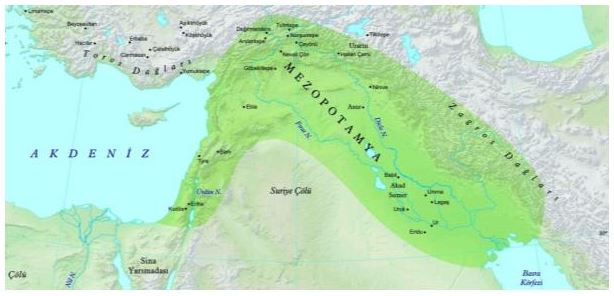Yazan: Asuman Kaplan Evlice ve Nusret Zencirci
Introduction
Wheat has an important place both in our country and in many countries due to its wide adaptability, easy cultivation, economical storage and transportation, high nutritional value, and nutritional habits of the communities (Okur 2017).
The homeland region of wheat is called the “Fertile Crescent” which includes parts of Türkiye, Iran, Iraq, Syria, Lebanon, Palestine, and Israel (Özberk et al. 2016, Figure 1). Archaeo-botanical studies show that wheat was first cultivated in Şanlıurfa Göbekli Tepe, located in southern Türkiye, around 10,000-8,000 BC (Dietrich et al. 2012). Wheat then spread to the lands south of Russia (Afghanistan, Turkmenistan, Uzbekistan, Kazakhstan, and Azerbaijan), parts of Ethiopia, eastern North Africa (Egypt and Sudan) and the regions surrounding the northern shores of the Mediterranean. Today, the ancestors of modern wheat still grow wild even on roadsides in Türkiye, Iran, Northern Iraq and Syria (Köksel and Çetiner 2015).
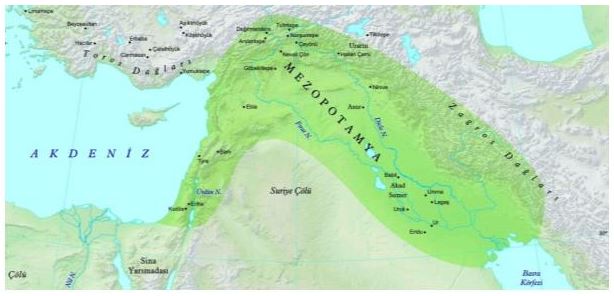
Şekil 1. Bereketli Hilal (Özberk ve ark. 2016)
Wheat has influenced human life economically, socially, and culturally, and humans have also influenced the evolution of wheat. Wild Siyez (Triticum boeticum) and Wild Gernik (T. dicoccoides) were first collected from nature. Later, these two wild species evolved into Siyez (T. monococcum L., kaplıca, iza/ıza, einkorn) and Gernik (T. dicoccum L., kavılca, çatal siyez, gacer, emmer) by natural selection (Özberk et al. 2016) from the hulled wheats cultivated by humans in Anatolia. Many of wheat landraces have been selected by farmers and nature to fit environmental conditions and cultural foods (Hernández-Espinosa et al. 2019).
Until the beginning of the 20th century, wheat cultivars were mostly landraces well adapted to the region. Later, as breeding methods developed, landraces were used as a source of variation in the development of modern wheat cultivars. With the wheat breeding studies carried out after the Second World War, landraces were replaced by modern bread and durum wheat cultivars with high yield, short plant height, non-lodging, and high response to fertiliser (Bordes et al. 2008, Lognin et al. 2016).
There are a total of 564 registered wheat cultivars, including 449 bread wheat (T. aestivum L.), 108 durum wheat (T. durum Desf.), 3 einkorn wheat (T. monococcum L.), 2 emmer wheat (T. dicoccum L.), and 2 spelt wheat (T. spelta L.) in our country which has a suitable ecology for growing wheat with high grain yield and quality (TTSMM 2023).
Wheat Production and Trade
Wheat maintains its place as a staple food in the world, and wheat-based foodstuffs, in addition to bread, meet a large part of the energy needs of developing countries. Therefore, the production and trade of wheat in the world gains great importance. World wheat production and trade data by years are given in Figure 2. World wheat production was 781 million tonnes and its trade was 197 million tonnes in the 2021-2022 growing season (TMO 2023).
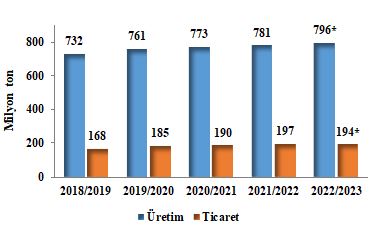
Figure 2. World Wheat Production and Trade Data (*: Estimate)
The shares of countries in wheat production and trade are given in Figure 3. When the figure is examined, China ranked first in terms of wheat production with a share of 17%, followed by EU (16%), India (14%), Russia (11%), USA (7%), and other countries (35%). In terms of export shares of countries, Russia ranked first with a share of 21%, followed by the EU (14%), Canada (14%), USA (14%), Australia (10%), and other countries (527) (TMO 2021).
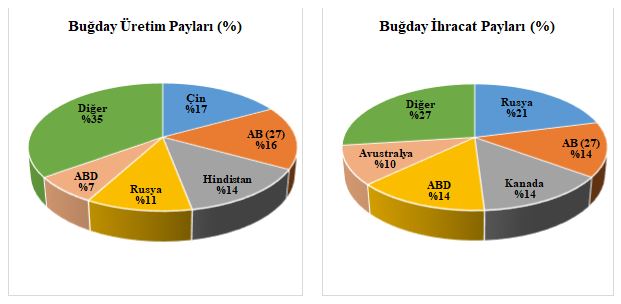
Figure 3. Shares of Countries in Wheat Production and Exports (%)
In the 2021-2022 growing season, approximately 5.4 million ha of bread wheat and 1.2 million ha of durum wheat were sown in Türkiye. The production amounts of bread and durum wheat were approximately 16.0 and 3.8 million tonnes, respectively. While the yield of bread wheat was 2960 kg/ha, the yield of durum wheat was 3140 kg/ha (Figure 4).
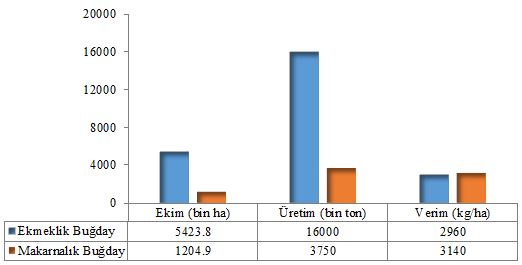
Figure 4. 2021-2022 Türkiye Bread and Durum Wheat Cultivated Area, Production and Grain Yield Values (TÜİK 2023)
Productions and Trades of Wheat Flour, Cookie, Pasta, and Bulgur
In our country, where per capita wheat consumption is 199 kg/year (TÜİK 2023), wheat is mostly consumed as bread, pasta, cookie, and bulgur.
Bread is one of the most stable foods in our country. Daily bread consumption varies greatly depending on consumers' lifestyle and habits. In Türkiye, bread is generally consumed within 24 hours after baking. Therefore, small and medium-sized local bakeries are quite common. There are approximately 23,000 small and medium-sized local bakeries, 2,500 artisan type bakeries, and 70 industrial bakeries in Türkiye. Public bread factories in Istanbul (1.8 million bread/day capacity), Ankara (1.5 million bread/day capacity), and other metropolitan cities of Türkiye operate as industrial bakeries with modern technological infrastructures (Köksel and Cetiner 2015).
There are 571 registered flour mills operating in our country with a total milling capacity of 30.1 million tonnes/year (TOBB 2023). Total flour production was approximately 10.8 million tons in 2022, and this amount was achieved by using approximately 1/3 of the total milling capacity (Table 1). There are also small-scale flour mills in rural areas, and some of the local people use these small mills to grind their wheat. Therefore, the actual amount of flour produced in Türkiye is estimated to be higher than the reported amounts (Köksel and Cetiner 2015).
Table 1. Amounts of wheat flour, cookie, pasta, and bulgur produced in Türkiye in 2010-2022 (tonnes) (TÜİK 2023)
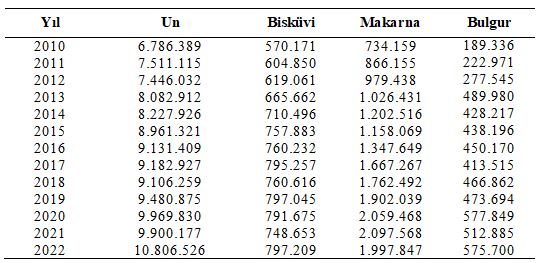
The amount subject to world flour exports is 12,838 thousand tonnes and Türkiye is in an important position by ranking first with 3,085 thousand tonnes. Türkiye exported flour to 111 different countries in 2022, with Iraq (1,256 thousand tonnes), Syria (337 thousand tonnes) and Yemen (324 thousand tonnes) being the leading countries (Figure 5).
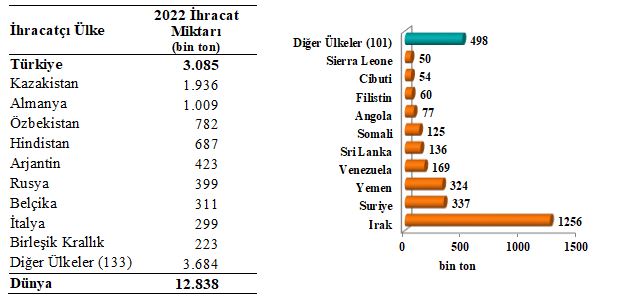
Figure 5. World Flour Export Amounts in 2022 (left) and Countries and their Amounts Exported by Türkiye (right) (TradeMap 2023)
There are around 50 cookie factories actively operating in Türkiye (Köksel and Cetiner 2015). Our cookie production, which was 570,171 tonnes in 2010, was 797,209 tonnes in 2022 (Table 1). In global cookie exports, Türkiye ranks 5th with 191,699 tonnes after Mexico, the Netherlands, Germany, and India. The leading export countries are Iraq with 52 thousand tonnes, Yemen with 16.4 thousand tonnes, Syria with 8.7 thousand tonnes, and Lebanon with 7.8 thousand tonnes (Figure 6).
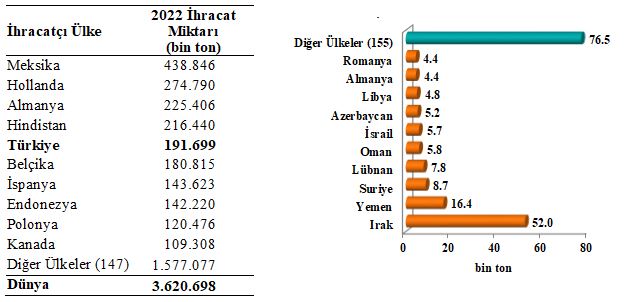
Figure 6. World Cookie Export Amounts in 2022 (left) and Countries and their Amounts Exported by Türkiye (right) (TradeMap 2023)
In the pasta sector in Türkiye, a total of 26 factories are actively producing with a capacity of 2.8 million tonnes/year. In this sector, 10 thousand people are employed directly and 100 thousand people are employed indirectly. Turkish pasta industry ranks 2nd in the world pasta production (TMSD 2022, Taşcı et al. 2022). Our pasta production, which was about 734 thousand tonnes in 2010, was approximately 2 million tonnes in 2022 (Table 1). Our country is one of the leading countries in world pasta exports and ranks second after Italy with 1,252 thousand tonnes of exports (Figure 7). Pasta produced in Türkiye is exported to a wide range of countries (143 countries) in the world. The leading countries are Venazuela (178 thousand tonnes), Somalia (155 thousand tonnes), Benin (91 thousand tonnes), and other countries (Figure 7).
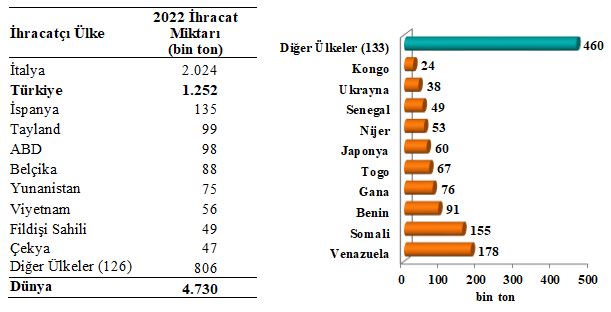
Figure 7. World Pasta Export Amounts in 2022 (left) and Countries and their Amounts Exported by Türkiye (right) (TradeMap 2023)
Bulgur is an important foodstuff that has been produced in Anatolia and Middle Eastern countries since the cultivation of wheat and is still consumed today. Bulgur, which has a history of approximately 4000 years, has been known by various names such as burghul, burgul, bulgor, and ala (Özboy 1998, Bayram and Öner 2002).
While bulgur production in our country was initially carried out in small scales and traditional methods in the villages to meet family needs, it has developed over time and has become an industrial sector today. The first industrial bulgur was produced in Karaman in order to meet the needs of the army during World War I (Özboy 1998). As of today, the average amount of bulgur consumed per capita in our country has reached 12 kg (Bayram 2000, Bayram and Öner 2002). This amount is 2.5 times the pasta consumption per capita and is a very important alternative to rice (Öner 2002). While our industrial bulgur production was approximately 189 thousand tonnes in 2010, it reached about 576 thousand tonnes in 2022 (Table 1). This amount increases even more when the production in homes and villages is added to this production (Bayram 2005). According to the industrial database of the Union of Chambers and Commodity Exchanges of Türkiye (TOBB), there are 96 bulgur factories in 24 different provinces in Türkiye. The annual bulgur production capacity of these factories is stated as 1,185,104 tonnes (TOBB 2023).
A significant amount of bulgur is exported by Türkiye since the bulgur produced in our country is yellow in colour, bright, smooth in shape, and suitable for the palate (Öner 2002). While bulgur export of Türkiye was approximately 71 thousand tonnes in 2008, this amount increased to roughly 253 thousand tonnes in 2022 (TÜİK 2023). Türkiye exported a total of 253,358 tonnes of bulgur to 105 different countries. Iraq ranked first among these countries with 73.7 thousand tonnes. This country was followed by Syria, Russian Federation, Germany, Belgium, Lebanon, Israel, Ukraine, Jordan, France, and other countries (95) in 2022 (Figure 8).
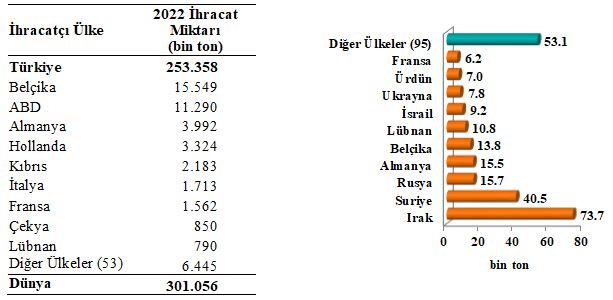
Figure 8. World Bulgur Export Amounts in 2022 (left) and Countries and their Amounts Exported by Türkiye (right) (TradeMap 2023)
Conclusion and Recommendations
Türkiye is one of the leading countries in the production and trade of wheat and its products. With the wheat breeding studies carried out in our country, wheat cultivars with high grain yield, high quality, and suitable for every region have been developed, and these studies are continuing. The continuity of production in wheat-based enterprises depends on the supply of raw materials in the required period, in the desired quality, quantity and standard, at a homogeneous and affordable price. For this reason, measures should be taken to increase our country's place in this sector by increasing the production of wheat with the desired characteristics.
References
Bayram, M. 2000. Bulgur around the world. Cereal Food World, 45, 80-82.
Bayram, M. 2005. Modelling of cooking of wheat to produce bulgur. Journal of Food Engineering, 71, 179-186.
Bayram, M., Öner, M.D. 2002. The new old wheat: convenience and nutrition driving demand for bulgur. World Grain, November, 51-53.
Bordes, J., Branlard, G., Oury, F.X., Charmet, G., Balfourier, F. 2008. Agronomic characteristics, grain quality and flour rheology of 372 bread wheats in a worldwide core collection. Journal of Cereal Science, 48, 569-579. https://doi.org/10.1016/j.jcs.2008.05.005
Dietrich, O., Heun, M., Notroff, J., Schmidt, K., Zarnkow, M. 2012. The role of cult and feasting in the emergence of Neolithic communities. New evidence from Göbekli Tepe, south-eastern Turkey. Antiquity, 86, 674-695. https://doi.org/10.1017/S0003598X00047840
Hernández-Espinosa, N., Payne, T., Huerta-Espino, J., Cervantes, F., Gonzalez-Santoyo, H., Ammar, K., Guzmán, C. 2019. Preliminary characterization for grain quality traits and high and low molecular weight glutenins subunits composition of durum wheat landraces from Iran and Mexico. Journal of Cereal Science, 88, 47-56. https://doi.org/10.1016/j.jcs.2019.05.007
Köksel, H., Cetiner, B. 2015. Future of grain science series: Grain science and ındustry in Turkey: past, present, and future. Cereal Foods World, 60, 90-96. https://doi.org/10.1094/CFW-60-2-0090
Longin, C.F.H., Ziegler, J., Schweiggert, R. et al 2016. Comparative study of hulled (einkorn, emmer, and spelt) and naked wheats (durum and bread wheat): Agronomic performance and quality traits. Crop Science, 56, 302-311.
Okur, Y. 2017. Ekmeklik buğday kalitesini değerlendirmede kullanılan kimyasal ve fiziksel özelliklerin incelenmesi (Yüksek Lisans Tezi). Hacettepe Üniversitesi, Ankara.
Öner, M.D. 2002. Bulgur sanayi, sorunları ve çözüm önerileri. Hububat 2002, Hububat Ürünleri Teknolojisi Kongre ve Sergisi, 3-4 Ekim, 39-48, Gaziantep.
Özberk, İ., Atay, S., Altay, F., Cabi, E., Özkan, H., Atlı, A. 2016. Türkiye’nin buğday atlası. WWF-Türkiye (Doğal Hayatı Koruma Vakfı), İstanbul, Türkiye.
Özboy, Ö. 1998. Bulgur üretiminde verim ve kalite belirlemede kullanılabilecek testler ile üretimin nişasta ve protein özellikleri üzerine etkileri. Doktora Tezi, Hacettepe Üniversite-si, Fen Bilimleri Enstitüsü, Gıda Mühendisliği Anabilim Dalı, 123, Ankara.
TardeMap 2023. Trade statistics for international business development. https://www.trademap.org. Erişim tarihi: 25.10.2023
Taşcı, R., Karabak, S., Şanal, T., Kaplan Evli̇ce, A., Sarı, G., Candemi̇r, S., Özercan, B., Bolat, M., Arslan, S., Bayramoğlu, Z. 2022. Türkiye’de makarna fabrikalarının buğday tedarik yapısı ve alım kriterleri. Türk Tarım ve Doğa Bilimleri Dergisi 9, 502-508. https://doi.org/10.30910/turkjans.1089455
TMO 2021. TMO Dünya Hububat ve Bakliyat Raporu. https://www.tmo.gov.tr/Upload/Document/hubbaklidurumu.pdf. Erişim tarihi: 27.10.2023
TMO 2023. T.C. Toprak Mahsulleri Ofisi Genel Müdürlüğü 85. Hesap Dönemi Faaliyet Raporu 22. https://www.tmo.gov.tr/Upload/Document/maliisler/2022faaliyetraporu.pdf, Erişim Tarihi: 27.10.2023
TMSD, 2022. Türkiye Makarna Sanayicileri Derneği / Resmi internet sayfası https://www.makarna.org.tr/anasayfa. Erişim tarihi: 02.02.2022
TOBB 2023. TOBB – Sanayi Veritabanı. https://sanayi.tobb.org.tr/ksorgu_harita5.php?kodu=10.61.21.00.02. Erişim tarihi: 27.10.2023
TTSMM 2023. Milli Çeşit Listesi. https://www.tarimorman.gov.tr/BUGEM/TTSM/Sayfalar/Detay.aspx?SayfaId=85. Erişim tarihi: 25.10.2023
TÜİK 2023. Türkiye İstatistik Kurumu. https://www.tuik.gov.tr/. Erişim tarihi: 25.10.2023

